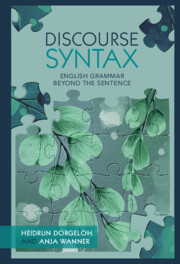Refine search
Actions for selected content:
6584 results in Grammar and Syntax
Part III - Grammar of Discourse
-
- Book:
- Discourse Syntax
- Published online:
- 20 October 2022
- Print publication:
- 27 October 2022, pp 159-288
-
- Chapter
- Export citation
Figures
-
- Book:
- Discourse Syntax
- Published online:
- 20 October 2022
- Print publication:
- 27 October 2022, pp viii-x
-
- Chapter
- Export citation
Glossary
-
- Book:
- Discourse Syntax
- Published online:
- 20 October 2022
- Print publication:
- 27 October 2022, pp 289-301
-
- Chapter
- Export citation
3 - Non-canonical Beginnings
- from Part II - Grammar in Discourse
-
- Book:
- Discourse Syntax
- Published online:
- 20 October 2022
- Print publication:
- 27 October 2022, pp 51-87
-
- Chapter
- Export citation

Discourse Syntax
- English Grammar Beyond the Sentence
-
- Published online:
- 20 October 2022
- Print publication:
- 27 October 2022
1 - Phonological Awareness, Orthography, and Learning to Read Chinese
- from Part One - Writing System/Neuro-cognitive Processing of Chinese
-
-
- Book:
- The Cambridge Handbook of Chinese Linguistics
- Published online:
- 04 August 2022
- Print publication:
- 18 August 2022, pp 3-22
-
- Chapter
- Export citation
10 - Compounding Is Semantics-driven in Chinese
- from Part Two - Morpho-lexical Issues in Chinese
-
-
- Book:
- The Cambridge Handbook of Chinese Linguistics
- Published online:
- 04 August 2022
- Print publication:
- 18 August 2022, pp 198-220
-
- Chapter
- Export citation
14 - Tonal Processes Defined as Tone Sandhi
- from Part Three - Phonetic-phonological Issues in Chinese
-
-
- Book:
- The Cambridge Handbook of Chinese Linguistics
- Published online:
- 04 August 2022
- Print publication:
- 18 August 2022, pp 291-312
-
- Chapter
- Export citation
13 - Tonal Processes Defined as Articulatory-based Contextual Tonal Variation
- from Part Three - Phonetic-phonological Issues in Chinese
-
-
- Book:
- The Cambridge Handbook of Chinese Linguistics
- Published online:
- 04 August 2022
- Print publication:
- 18 August 2022, pp 275-290
-
- Chapter
- Export citation
Part One - Writing System/Neuro-cognitive Processing of Chinese
-
- Book:
- The Cambridge Handbook of Chinese Linguistics
- Published online:
- 04 August 2022
- Print publication:
- 18 August 2022, pp 1-44
-
- Chapter
- Export citation
28 - Topicalization Defined by Syntax
- from Part Four - Syntax-semantics, Pragmatics, and Discourse Issues
-
-
- Book:
- The Cambridge Handbook of Chinese Linguistics
- Published online:
- 04 August 2022
- Print publication:
- 18 August 2022, pp 616-634
-
- Chapter
- Export citation
5 - Parts of Speech in Chinese and How to Identify Them
- from Part Two - Morpho-lexical Issues in Chinese
-
-
- Book:
- The Cambridge Handbook of Chinese Linguistics
- Published online:
- 04 August 2022
- Print publication:
- 18 August 2022, pp 97-113
-
- Chapter
- Export citation
7 - Derivational and Inflectional Affixes in Chinese and Their Morphosyntactic Properties
- from Part Two - Morpho-lexical Issues in Chinese
-
-
- Book:
- The Cambridge Handbook of Chinese Linguistics
- Published online:
- 04 August 2022
- Print publication:
- 18 August 2022, pp 135-157
-
- Chapter
- Export citation
30 - Grammatical Acceptability in Mandarin Chinese
- from Part Four - Syntax-semantics, Pragmatics, and Discourse Issues
-
-
- Book:
- The Cambridge Handbook of Chinese Linguistics
- Published online:
- 04 August 2022
- Print publication:
- 18 August 2022, pp 669-706
-
- Chapter
- Export citation
15 - Tonal Processes Conditioned by Morphosyntax
- from Part Three - Phonetic-phonological Issues in Chinese
-
-
- Book:
- The Cambridge Handbook of Chinese Linguistics
- Published online:
- 04 August 2022
- Print publication:
- 18 August 2022, pp 313-335
-
- Chapter
- Export citation
18 - Perceptual Normalization of Lexical Tones
- from Part Three - Phonetic-phonological Issues in Chinese
-
-
- Book:
- The Cambridge Handbook of Chinese Linguistics
- Published online:
- 04 August 2022
- Print publication:
- 18 August 2022, pp 383-404
-
- Chapter
- Export citation
24 - The Syntax of Classifiers in Mandarin Chinese
- from Part Four - Syntax-semantics, Pragmatics, and Discourse Issues
-
-
- Book:
- The Cambridge Handbook of Chinese Linguistics
- Published online:
- 04 August 2022
- Print publication:
- 18 August 2022, pp 515-549
-
- Chapter
- Export citation
Part Three - Phonetic-phonological Issues in Chinese
-
- Book:
- The Cambridge Handbook of Chinese Linguistics
- Published online:
- 04 August 2022
- Print publication:
- 18 August 2022, pp 221-404
-
- Chapter
- Export citation
Index
-
- Book:
- The Cambridge Handbook of Chinese Linguistics
- Published online:
- 04 August 2022
- Print publication:
- 18 August 2022, pp 707-714
-
- Chapter
- Export citation
9 - On an Integral Theory of Word Formation in Chinese and Beyond
- from Part Two - Morpho-lexical Issues in Chinese
-
-
- Book:
- The Cambridge Handbook of Chinese Linguistics
- Published online:
- 04 August 2022
- Print publication:
- 18 August 2022, pp 174-197
-
- Chapter
- Export citation
